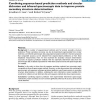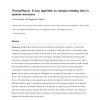BMCBI
2008
13 years 11 months ago
2008
Background: Slow-fast analysis is a simple and effective method to reduce the influence of substitution saturation, one of the causes of phylogenetic noise and long branch attract...
BMCBI
2008
13 years 11 months ago
2008
Background: A number of sequence-based methods exist for protein secondary structure prediction. Protein secondary structures can also be determined experimentally from circular d...
BMCBI
2008
13 years 11 months ago
2008
Background: Genes that are co-expressed tend to be involved in the same biological process. However, co-expression is not a very reliable predictor of functional links between gen...
BMCBI
2008
13 years 11 months ago
2008
Background: Recognizing similarities and deriving relationships among protein molecules is a fundamental requirement in present-day biology. Similarities can be present at various...
BMCBI
2008
13 years 11 months ago
2008
Background: In systems biology, and many other areas of research, there is a need for the interoperability of tools and data sources that were not originally designed to be integr...
BMCBI
2008
13 years 11 months ago
2008
Background: There are several situations in population biology research where simulating DNA sequences is useful. Simulation of biological populations under different evolutionary...
BMCBI
2008
13 years 11 months ago
2008
Background: A priori analysis of the activity of drugs on the target protein by computational approaches can be useful in narrowing down drug candidates for further experimental t...
BMCBI
2008
13 years 11 months ago
2008
Background: Non-homology based methods such as phylogenetic profiles are effective for predicting functional relationships between proteins with no considerable sequence or struct...
BMCBI
2008
13 years 11 months ago
2008
Background: Interaction of a drug or chemical with a biological system can result in a geneexpression profile or signature characteristic of the event. Using a suitably robust alg...






